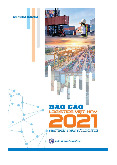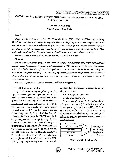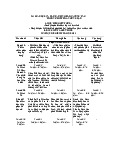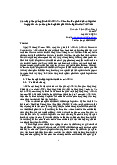



















Preview text:
MISNISTRY OF EDUCATION AND TRAINING HOA SEN UNIVERSITY FACULTY OF ECONOMICS - MANAGEMENT ------- - ------
Ho Chi Minh city, June 2023 FINAL REPORT Topic: Transportation Subject: Logistics Subject class: 0100
Instructor guides: Mrs. Phuong Lien Members: No. Student code Full name Contribution 1 22110030 Trịnh Lan Anh 2 22115228 Phan Lê Phúc Thảo 3 22011181 Nguyễn Đan Nhi 4 22108678 Nguyễn Ngọc An Kỳ 5 22114132 Lê Thị Minh Ngọc 6 22012393 Nguyễn Ngọc Đăng Na 7 22007488 Phương Mỹ Khanh TABLE OF CONTENTS
I. General Overview of Transportation..........................................4 1.
Types of transportation.......................................................4 2.
Specifications and Methods................................................8
II. The Main Types of Logistics Services.....................................10
1. Core Freight Logistics Services:..........................................10
2. Related Freight Logistics Services:.....................................11
III. Forms of Logistics Service Provision....................................11
1. First-Party Logistics (1PL):...................................................11
2. Second-Party Logistics (2PL):..............................................12
3. Third-Party Logistics (3PL) or Contract Logistics:.............12
4. Fourth-Party Logistics (4PL) or Supply Chain Logistics:. .12
IV. Overview of Panda Global Logistics VIETNAM.....................13
V. Document goods:......................................................................17
VI . Incoterms.................................................................................33
VII. Conclusion..............................................................................35 DEAR
I want to extend my heartfelt appreciation to all the
instructors who took the time to review my report
article. Your constructive feedback and insightful
comments have been instrumental in refining my
writing skills and deepening my understanding of the
subject matter. Your commitment to providing
thorough and thoughtful evaluations has not only
improved the quality of my work but has also instilled
in me a sense of continuous improvement. I am grateful
for the dedication you have shown in guiding me
through the nuances of effective communication and
critical thinking. Your expertise and encouragement
have been invaluable, and I am genuinely thankful for
the investment you've made in helping me grow as a
writer and a student. Thank you for your time,
expertise, and the positive impact you have had on my academic journey.
Overview of Various Transport Services
1) FCL: Full Container Load - Transportation of full container loads.
2) LCL: Less Than Container Load - Transportation of partial
container loads, typically for smaller shipments.
3) FWD: Forwarder - A company or individual that arranges and
manages shipments for customers.
4) EVFTA: European Union-Vietnam Free Trade Agreement - A trade
agreement between Vietnam and the European Union.
5) USD: United States Dollar - The currency of the United States.
8) D/O: Delivery Order - A document that authorizes the release of goods to the consignee.
10) BL: Bill of Lading - A legal document that provides details about
cargo being shipped and serves as a receipt of shipment.
11) A/N: Arrival Notice - A notification sent to the consignee or
receiver about the arrival of the cargo.
12) Panda: Panda Global Logistics - A logistics company based in Vietnam.
13) SME: Small and Medium Enterprise - Businesses that are not
large corporations and fall within a specific size range.
14) GATS: General Agreement on Trade in Services - A treaty of the
World Trade Organization (WTO) that deals with trade in services.
15) WTO: World Trade Organization - An international organization
that deals with global trade rules and agreements.
I. General Overview of Transportation 1. Types of transportation 1.1 Road transportation
- Road transportation is the activity of using various types of
vehicles (such as cars, motorcycles, bicycles, trucks, buses,
etc.) to move goods or passengers on a road system,
including national highways, provincial roads, city streets, and rural roads.
Advantages of Road Transportation
Disadvantages of Road Transportation
Flexibility: Not limited by fixed routes.
Traffic congestion in urban areas.
Easy access from the starting point to the
Environmental impact with vehicle final destination. emissions.
High frequency with no dependence on fixed
Higher risk of accidents compared to some schedules. other modes.
High frequency with no dependence on fixed
Higher risk of accidents compared to some schedules. other modes.
Adaptability with quick adjustments based
Weight and size limitations for large or on demand. heavy goods.
No need for large infrastructure investment.
Efficiency and safety affected by adverse weather.
Diverse cargo transportation.
Expensive road maintenance costs.
Personalized service, such as door-to-door
Less efficient for long distances compared delivery.
to air or rail transport.
Causes noise pollution, affecting the quality of life. 1.2 Rail transportation.
- Rail transport is also known as train transport. It is a means of
transport, on vehicles which run on tracks (rails or railroads).
Advantages of Rail Transportation
Disadvantages of Rail Transportation
Efficiency: Can carry large quantities of
Limited flexibility with fixed routes and
passengers or goods efficiently. schedules.
Cost-effective in terms of fuel consumption
High initial investment in infrastructure. and maintenance.
Environmentally friendly with lower
Dependence on infrastructure, susceptible
greenhouse gas emissions. to weather disruptions.
Ability to transport bulky goods over long
Slower than air transportation for long- distances. distance travel.
Reliable and safe mode of transportation.
Lower speed compared to road and air transportation.
Contributes to sustainable transportation
Limited accessibility to some areas due to systems. fixed routes. 1.3 Maritime transportation
- Maritime transport refers to the use of vehicles operating on
water, such as ships and boats, to transport passengers and goods.
Advantages of Maritime Transportation
Disadvantages of Maritime Transportation
Cost-effective, reduces risks, ensures traffic
Highly dependent on weather conditions,
stability, and lowers pollution compared to
affecting schedules and safety. road transportation.
Suitable for transporting bulky goods and
Ships typically have slower travel speeds.
facilitating international trade.
Capitalizes on geographical locations and
Goods preservation can be challenging due
seaports, promoting trade and the economy. to rough seas.
Provides essential access to seaports for
Limited to transporting goods to seaports,
requiring additional transportation methods international trade.
to reach final destinations. 1.4 Air transportation.
- Air transportation is a part of the global transportation system
in which goods, passengers, and cargo are moved through the air using airplanes.
Advantages of Air Transportation
Disadvantages of Air Transportation
Speed and Time Efficiency High Costs Global Connectivity Environmental Impact
Convenience and Flexibility
Restrictions on Payload and Space Safety Airport Congestion
Versatility in Applications Weather Dependency
Overcoming Geographic Barriers Security Control
Environmental Impact Mitigation Fierce Competition
Limitations in Transporting Sensitive and Specialized Cargo 1.5
Pipeline transportation.
- Pipeline transportation is a continuous mode of transporting
goods through a tubular system designed to traverse various
terrains from the origin to the destination. These pipelines can
connect international locations, enabling goods to move from one country to another. Aspect Advantages Disadvantages Cost-effectiveness
- Cost-effective for long-
- Costly repairs in case of distance transport malfunctions Safety and security
- Designed with multiple
- Risk of explosions and safety measures fires due to flammable materials Efficiưency - Quick and efficient
- Environmental hazards like
transport of large quantities oil spills Reliability
- Proven track record of
- Large land areas required reliability for pipelines Reliability
- Proven track record of
- Large land areas required reliability for pipelines
2. Specifications and Methods
2.1 20'GP Shipping Container (General Purpose)
- The 20’ container is the most cost efficient way to transport the
goods to yourbuyer. It is known as a ‘Twenty-Footer’ to signify the
overall length of 20 feet. Products are usually packed inside cartons,
then cartons stacked and wrapped onto pallets and loaded inside
the container for transport. A popular way of exporting palletised
cargo is 2 pallets high, 2 pallets wide, 8 pallets deep – 16 pallets total.
2.2 40'GP Shipping Container (General Purpose)
- The 40’ shipping container is the same design as the 20’ container
but justdouble the length. So the overall length is 40 feet and can
hold double the amount of cargo.
2.3 40'HC Shipping Container (High-Cube)
- The 40’ High Cube shipping container is the same overall length as
the40’GP but it is approximately 40cm taller than the GP. This slight
increase in height allows for an extra 10-15% of cargo to be loaded
inside. It alsoallows for some different packing methods which can
fit extra cargootherwise unable to load inside a normal 40’GP container
2.4 LCL Cargo (Less Than Container Load)
- LCL shipping is a shipping method used for smaller cargo when
the overall size of the goods for export isnot big enough to fill a 20’
container. When LCL shipping is used, the goods are still loaded
inside a 20’shipping container and transported the exact same way
but the goods are loaded inside a shared shippingcontainer along
with other party’s cargo to fill the container (a consolidated container).
- The freight cost is charged out depending on the overall product
size or weight, the shipping rate will be charged out per cubic meter
of cargo (m3) or per Metric Tonne (1,000kg) in weight, whichever is greater.
- There are more handling costs involved when shipping LCL cargo
as pallets have to be loaded andunloaded more often, incurring more handling charges. 2.5 Breakbulk Cargo
- Breakbulk Cargo is not a very popular shipping method as it’s
generallyused for oversized cargo that can’t fit inside shipping
containers. Anycargo that exceeds the length, height or weight
restrictions of a 40′container will be shipped by breakbulk cargo.
Cargo is loaded on top of the deck of the vessel and has to be
carefully loaded into place on the top of the deck by crane. Large
machinery, boats and steel are examples of goods that are exported
around the world by Breakbulk Cargo.
- The cargoes carried by maritime transportation come into several
categories, each requiring the usage of specialized ships. The two
main categories are general and bulk cargo. General cargo is
unitized (carried in defined load units), while bulk cargo is loose
(carried in any quantity). General cargo can be sub-divided into three categories:
● Break Bulk. Concerns cargo that is carried in drums, bags,
pallets, or boxes. Such ships are typically geared.
● Neo Bulk. Concerns cargo where each pre-packaged unit is
accountable such as lumber (bundles), paper (rolls), steel, and vehicles.
● Containerized. The growth of container shipping required
creating a new general cargo category where the cargo is
being carried in container load units.
- Bulk cargo can be divided into two categories:
● Liquid bulk. The majority of the liquid bulk carried is
petroleum LNG (Liquefied Natural Gas), representing an
emerging segment. Liquid bulk ships are commonly referred to as tankers.
● Dry Bulk. Concerns a wide variety of materials such as coal,
iron ore, grains, bauxite, and sand.
II. The Main Types of Logistics Services
- According to the General Agreement on Trade in Services (GATS)
of the World Trade Organization (WTO), logistics services are categorized as follows:
1. Core Freight Logistics Services:
● Core logistics services are those that account for a significant
portion of total logistics costs and have a decisive impact on
other logistics services. Core logistics services include:
● Cargo handling services, including lifting and container handling.
● Warehousing services, including operating container yards and inventory handling.
● Customs brokerage services.
● Other support services, such as transportation-related
information management, handling and reprocessing of
damaged goods, and leasing and purchasing of empty containers.
2. Related Freight Logistics Services:
- These services are related to transportation and include: ● Sea transport services.
● Inland waterway transport services.
● Air transport services.
● Rail transport services.
● Road transport services.
● Pipeline transport services.
C. Non-core Freight Logistics Services:
- These services are complementary but non-essential and include:
● Inspection and technical analysis services. ● Postal services.
● Retail trade services, including collection, consolidation,
sorting, distribution, and delivery.
● Other supporting services.
III. Forms of Logistics Service Provision
- The field of logistics encompasses various processes and
stages, which can be classified into four modes of logistics operations:
1. First-Party Logistics (1PL):
This term is applied to companies that perform their logistics
activities in-house. These companies typically own transportation
vehicles, warehouses, lifting equipment, and other resources,
including both human and mechanical resources. These are usually
large companies or even global conglomerates with extensive global
logistics networks that adapt their operations to local circumstances.
2. Second-Party Logistics (2PL):
This concept refers to traditional logistics activities such as
transportation or warehousing. These are often companies that do
not own or do not have sufficient transportation means.
Infrastructure services such as lifting and handling may be
outsourced to provide necessary equipment and services. This
approach aims to reduce costs or capital investment, and it is
commonly adopted by companies with limited resources.
3. Third-Party Logistics (3PL) or Contract Logistics:
This approach involves using external companies to carry out
various logistics activities. In other words, 3PL is logistics activities
tailored to their clients and could be contractual or not. It is a close
partnership between a client company and a logistics service
provider, working not only to execute logistics activities but also to
share information, risks, and benefits under a long-term contract.
4. Fourth-Party Logistics (4PL) or Supply Chain Logistics:
The 4PL is considered a single contact point where it manages and
integrates the 3PL functions in the distribution process. A 4PL does
not only implement logistics activities but also shares information,
risks, and benefits through a long-term contract, and it goes beyond
that to manage and integrate other logistics activities in the distribution process.
These logistics companies can be further divided into those that
own tangible assets and those that do not. Companies that own
tangible assets have their transport fleets, warehouses, and use
these assets to manage all or part of their logistics activities.
Logistics companies without tangible assets operate as
intermediaries and often have to outsource their basic services,
such as transportation, warehousing, ports, etc. The practice of
outsourcing logistics services is commonly referred to as "outsourcing."
IV. Overview of Panda Global Logistics VIETNAM
4.1 Company Introduction:
● Company Name: Panda Global Logistics Co., Ltd.
● English Trading Name: Panda Global Logistics Co., Ltd.
● Headquarters: 4th Floor, HDTC Building, 36 Bui Thi Xuan
Street, Ben Thanh Ward, District 1, Ho Chi Minh City.
● Phone Number: 028 3911 0025
● Fax: 028 3925 9112 (14)
● Business Tax Code: 0305538963 (Issued by the Department of
Planning and Investment on February 22, 2008)
● Legal Capital: VND 1,000,000,000 (One billion Vietnamese Dong)
● Company Representative: Mr. Than Ngoc Hieu
● Website: [www.pandalog.com](http://www.pandalog.com)
● Email: info.hcm@panda4u.com 4.2 Company Size:
● Main Headquarters: Panda Int’l Transportation Co., Ltd.
● Address: 104, 5F, No.209, Civic BLVD, Taipei, Taiwan
4.3 Vietnam Branch Offices:
● Ho Chi Minh City: 4th Floor, HDTC Building, 36 Bui Thi Xuan,
Ben Thanh Ward, District 1, Ho Chi Minh City.
● Hanoi: 21st Floor, Ceo Building, HH2-1, Pham Hung Street, Me
Tri Ward, Nam Tu Liem District, Hanoi.
● Hai Phong: 8th Floor, DK Building, 2 Lot 22 Le Hong Phong
Street, Dong Khe Ward, Ngo Quyen District, Hai Phong City.
● Da Nang: 346 2/9 Street, Hoa Cuong Bac Ward, Hai Chau District, Da Nang City.
4.4 International Branch Offices:
● New York: No 179 - 2 150th Avenue Jamaica, NY11434.
● California: 1 Civic Plaza Drive Suite, 555 Carson, CA 90745.
● Malaysia: Suite 6A, 19th Floor, Wing B, Northam Tower, 57,
Jalan Suitan Ahmad Shah, 10050 Penang, Malaysia.
● China: 17F, Building C, The Silvabay Tower, No.469 Wu Song Road, Shanghai, 200080.
● Hong Kong: Unit C on 22/F, Roxy Industrial Centre, 58 - 66 Tai
Lin Pai Road, Kwai Chung, N.T. Hong Kong.
● Taichung: 26F, No.447, Sec 3, Wenxin RD, Beitun Dist,
Taichung City 406, Taiwan.
● Kaohsiung: 8F - 2, No.29, Hai - Pien RD, Lin Ya District,
Kaohsiung, Taiwan 80248 (R.O.C).
● Myanmar: No.440/442, 8th Floor, Rm (8/B), Merchant Road,
Corner of 44th Street, Botahtaung Township, Yangon, Myanmar.
● Philippines: Unit 1207 Cityland Condominium Tower I, 156 H.V.
Dela Costa St. Brgy Bel Air, Makati City, Philippines 1227.
● Singapore: 1090 Lower Delta Road, #05 - 05 Singapore 169201.
4.5 Company's History and Development:
- Panda Global Logistics Co., Ltd. was established in April 1989,
pioneering in maritime transportation. By 1997, Panda expanded its
business operations to include air transportation and initiated the
establishment of subsidiary companies in 1995.
- On March 1, 2008, the company officially expanded its presence
and opened its first office in Ho Chi Minh City, Vietnam, under the
name "Panda Global Logistics Member Limited Company," as per
business license number 4104003491.
- In March 2018, the company officially changed its name to "Panda
Global Logistics Co., Ltd." and continues to operate under this
name. Over the 13 years of operation in the Vietnamese market, the
company has developed the capacity to provide logistics services,
domestic and international import and export processes. With
flexibility and adaptability to market trends, Panda Logistics is
gradually expanding its business service network, establishing a
stable and solid position in the field of freight transportation, while
building lasting relationships with domestic and international clients.
- Currently, with over 4,500 employees, Panda is advancing towards
becoming a leading brand in the international cargo transport sector.
4.6 Vision and Mission of the Company:
- Vision: To become a highly influential enterprise in the field of
logistics in the Vietnamese market and be an attractive partner for
both domestic and international clients.
- Business Philosophy: Sustainable operations and profit sharing.
- Quality Policy: Services are of utmost importance. Always aiming for customer satisfaction.
4.7 Core Values of the Company
- Respect for Customers: Customers are the foundation of all business activities.
- Respect for Benefits: Harmoniously combining the interests of
customers, employees, and the community, as a common thread
throughout all business operations.
- Respect for the Collective: Building a cohesive, supportive,
civilized team that is always eager to learn, exchange information, and progress.
- Technological Innovation: Continuously updating changes in
science and technology to enhance service quality and reduce transaction time.
- Brand Reputation: Reputation and brand are core values in
improving service quality and competitive capabilities.
- Professionalism: Employees of the company are continuously
updated with changes in procedures, receiving comprehensive
training in the fields of logistics, import-export, and maritime.
- Personal Responsibility: The company's personnel are transparent,
responsible, displaying a high degree of professionalism and
creativity. This is the basis of the company's success.
4.8 Functions, Duties, and Business Scope of the Company
- The company provides the following functions:
Freight forwarding and customs brokerage.
Ocean and air freight transportation.
Domestic transportation, cargo handling, and warehousing services.
Road transportation on routes between Vietnam-Laos,
Vietnam-Cambodia, and vice versa.
Inventory management and other supply chain management services.
Consulting and assisting businesses when entering
international trade, covering a wide range of goods, including
machinery, food, furniture, and other permitted import-export items.
- The mission of the company includes building trust and loyalty
among customers and effective capital management. The company
is committed to continuously improving its services and expanding
its international import and export business operations.
- The company's business scope covers a wide range of activities in
the logistics sector, including sea and air cargo transportation,
customs brokerage, and much more.
Table 4.1. Diagram of Panda Global Logistics' Areas of Operation PANDA GLOBAL LOGISTICS
Customs Brokerage Services Air Sea Dom Cust Ware Freig Freig estic oms housi ht ht Trans Decla ng Trans Trans porta ratio Servi porta porta tion n ces tion tion Servi ces
(Source: Sales Department; Panda Logistics Company)
Export-Import Consignment
: With the increasing
specialization of the market, Panda Logistics provides
consignment export-import services to support customers
who do not have experience in the field or want to ensure
safety and cost-effectiveness.
Air Freight Transportation
: Providing air freight services
according to customer needs, especially for priority items
requiring fast transportation such as food, fruits, equipment
for disease prevention, etc.
Sea Freight Transportation
: Ensuring the transportation of
goods by sea, especially for bulk cargo. Typically, full
container load (FCL) goods like rice, furniture, electronic
components are shipped this way. Additionally, it is also
applicable to customers with less-than-container load (LCL)
requirements to save costs.
Domestic Transportation:
Road transport is an integral part of
Panda Logistics' goods transportation chain. The company's
professional transport team handles the delivery of goods
from ports and airports to the recipient's warehouses and
factories. This includes container trucks for full container load
(FCL) goods and smaller trucks corresponding to the weight
for less-than-container load (LCL) goods. They are highly
flexible in choosing the most efficient routes.
Customs Declaration Services
: Panda Logistics receives
customs declaration procedures for various types of goods.
After receiving the required documents from the customer (or
preparing the documents based on the information in the
customer's Purchase Order), they proceed with electronic
customs declaration, calculate import/export taxes, submit
customs documents, and take responsibility for customs
clearance and delivery to the requested address.
Warehouse Services:
Providing support and advice to
customers for storing goods in warehouse areas, customs-
bonded warehouses, and ICD Long Binh, which has over 3000
square meters of space. The company employs Warehouse
Management Systems (WMS) and CCTV cameras to manage
and monitor these facilities, making it a preferred choice for
customers in the Dong Nai and Binh Duong regions. V. Document goods: 5.1 Definition
- The C/O (Certificate of Origin) is an important document in import
and export. The C/O indicates the origin of goods, specifying in
which territory or country they were produced. 5.2 Types of C/O
- The Certificate of Origin (C/O) can come in various forms
depending on the trade agreements and regions. Some common forms of C/O include:
● Form A: Often associated with the Generalized System of
Preferences (GSP), which allows exporters in developing
countries to pay less or no duties on their exports to developed countries.
● Form B: This is commonly used among ASEAN countries
under the ASEAN Trade in Goods Agreement (ATIGA).
● Form E: Used for exports under the China-ASEAN Free Trade Agreement.
● Form D: Used for exports under the ASEAN-Japan
Comprehensive Economic Partnership (AJCEP).
● Form F: Used in the framework of the China-Chile Free Trade Agreement.
● Form AK: Pertains to trade between ASEAN and South Korea.
● Form AJ: For trade between ASEAN and Japan.
● Form AI: For trade between ASEAN and India.
● Form CT: Used under the Commonwealth Preferential Tariff Scheme.
● Form EUR.1: Used for goods that qualify for preferential trade
between European Union countries and other associated countries.
● Form CO: A generic Certificate of Origin form that doesn't
necessarily pertain to any preferential trade agreement. 5.3 Picture C/O
There are two main types of C/O:
+ Non-preferential C/O: This C/O merely certifies the origin of goods
and does not offer any preferential tariff benefits.
+ Preferential C/O: This C/O allows for reduced or exempted
customs duties in countries that extend this privilege. It not only
certifies the origin but also offers preferential tariff benefits for the goods listed on the C/O. C/O formats:
+ (no incentives) CO form A: For imports/exports between Vietnam
and countries that provide Vietnam with the Generalized System of
Preferences (GSP) tariff advantages.
+ ( incentives ) C/O from D :is a certificate of origin, applicable to
exports to ASEAN countries. Certificate of origin helps businesses
determine the origin of goods, and based on product policies to enjoy tax incentives.
5.4 Below is a simple example describing the content of a C/O: - Certificate of origin.
- Exporter's name and address.
- Importer's name and address. - Mode of transport.
- Place and date of issuance. - Description of goods. - Product code. - Product name. - Quantity. - Origin.
- Issuing organization.
● Depending on the regulations of each country or trade
agreement, the C/O can contain detailed information that must
be correctly filled out to avoid any issues during importation.
This is just a basic example, and the reality can be much more complex.
5.5 The Certificate of Origin (C/O) verifies the origin of goods based on several basic criteria:
● Origin of the goods: Goods must be produced in the country requesting the C/O.
● Composition and materials: The majority must originate from
that country or countries within the same agreement.
● Production process: The production process in that country needs verification.
● Related documentation: Such as invoices, packing lists, and shipping documents.
● Inspection and verification: May require checks by
government agencies or a third party.
● Essential information: Including the names and addresses of
the exporter and importer, description of the goods, quantity, and date of issuance.
=> The criteria may vary depending on each country's regulations or specific trade agreements. 5.6 Sale contact:
- A sale contract (sometimes referred to as a “sale of goods
contract” or simply “sales agreement”) is a legal agreement
between two parties, the seller (who is offering the item for sale)
and the buyer (who is purchasing the item). The contract outlines
the terms and conditions related to the sale of goods or property.
Some types of Sale Contract:
1. Parties Involved: The names and addresses of the buyer and seller.
2. Description of Goods: A clear and detailed
description of the item or items being sold.
3. Price: The agreed-upon price for the goods, as well
as any additional fees or taxes.
4. Payment Terms: Specifies how and when the buyer
will pay the seller. This could include details about
installments, due dates, acceptable forms of payment,
and penalties for late payments.
5. Delivery Terms: Details regarding when and how the
item will be delivered to the buyer.
6. Warranties and Representations: Any warranties
provided by the seller about the condition of the goods
or a disclaimer if no warranties are given.
7. Risk of Loss: Specifies which party is responsible for
the risk of loss or damage to the goods during delivery.
8. Termination Clause: Terms under which the contract
can be terminated, and the consequences of termination.
9. Dispute Resolution: Specifies how disputes related
to the contract will be handled, such as through arbitration or litigation.




